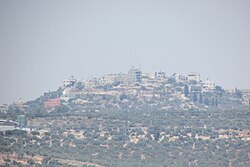History
Byzantine ceramics have been found in the village. [4]
Fara'ata was noted in the Samaritan Chronicle (from the 12th century) under the name of Ophrah, while it has been known under its present name since the 14th century. [5]
Ottoman era
Far'ata was incorporated into the Ottoman Empire in 1517 with all of Palestine, and in 1596 it appeared in the tax registers as Fara'ta, being in the Nahiya of Jabal Qubal of the Liwa of Nablus. It had a population of 12 households and 6 bachelor, all Muslim. The villagers paid a fixed tax rate of 33,3% on a number of crops, including wheat, barley, summer crops, olive trees, goats and beehives, in addition to occasional revenues, a press for olive oil or grape syrup, and a fixed tax for people of Nablus area; a total of 4,500 Akçe. [6]
In 1838, Fer'ata was noted as located in Jurat Merda, south of Nablus. [7]
In 1870 the French explorer Victor Guérin visited Far'ata, which he described having "a very small number" of people, with some cisterns and remains of a stone sarcophagus as remnants of former history. [8]
In 1870/1871 (1288 AH), an Ottoman census listed the village with a population of 10 households in the nahiya (sub-district) of Jamma'in al-Awwal, subordinate to Nablus. [9]
In the PEF's Survey of Western Palestine (SWP) (1882), Far'ata was described as a "small village of ancient appearance, standing on a [..] mound, with a rock-cut tomb to the south, and a sacred Mukam to the east." [5]
British Mandate era
In the 1922 census of Palestine conducted by the British Mandate authorities, Far'ata had a population of 36, all Muslim, [10] increasing in the 1931 census to of 47 Muslims, in a total of 11 houses. [11]
In the 1945 statistics the population of Far'ata was 70 Muslims, [12] while the total land area was 1,664 dunams, according to an official land and population survey. [13] Of this, 56 were allocated for plantations and irrigable land, 961 for cereals, [14] while 10 dunams were classified as built-up areas. [15]
This page is based on this
Wikipedia article Text is available under the
CC BY-SA 4.0 license; additional terms may apply.
Images, videos and audio are available under their respective licenses.



